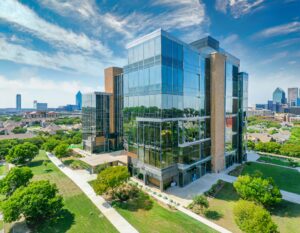Page Contents
- Dallas-Fort Worth Multi-Family Market Summary
- Rising Demand and Higher Vacancies
- Strong Structural Drivers Amid Economic Uncertainty
- Varied Vacancy Rates Across Submarkets
- Employment Growth Supporting Apartment Demand
- Competitive Housing Market Boosting Rentals
- Divergent Trends in Property Segments
- Steady Construction Pace Amid Challenges
- Northern Suburbs Leading Construction Activity
- Urban Areas Adding Significant Inventory
- Maintaining the Top Spot in Apartment Investment
- Slowing Deal Velocity and Volume
- Impact of Rising Interest Rates on Market Dynamics
- Shift in Investor Focus to Dallas-Fort Worth
- Final Thoughts
Dallas-Fort Worth Multi-Family Market Summary
- Recovering Demand: The multi-family demand in Dallas-Fort Worth is showing signs of recovery, with more households willing to sign new leases.
- Challenging Market Conditions: Despite the recovering demand, the market faces challenges due to economic uncertainty and high inflation impacting household formation.
- Increasing Vacancy Rates: The vacancy rate has risen from a low of 5.9% in mid-2021 to 8.8%.
- Declining Rent Growth: Rent growth has weakened, turning negative with a 0.4% change over the past year.
- Net Absorption Rates: Net absorption of 9,040 units is on par with the average levels of 2016 and 2017 but below the higher levels of 2018 and 2019.
- Geographical and Quality Variance in Demand: Demand varies across different areas and property types. High-quality suburban areas like Frisco/Prosper, Denton, and Allen/McKinney continue to show healthy demand.
- Economic Stress Impact: Lower-rated properties (3-star and below) are losing occupancy, reflecting the economic challenges faced by mid- and lower-income households.
- Resilient Mid-Tier Rent Growth: Despite occupancy losses, the 3-Star segment shows more resilient rent growth, not directly competing with newer developments.
- Construction Impact on Rent Growth: Areas with heavy construction activity are experiencing weaker rent growth, with more properties offering concessions to attract tenants.
- Stable Construction Pace and Investor Interest: The pace of construction remains manageable, and despite rising interest rates and softening asset values, there is continued investor interest in the market.
Rising Demand and Higher Vacancies
 Demand Increase: The demand for multi-family units in Dallas-Fort Worth has seen an uptick, with 9,040 units being filled. However, due to weaker net absorption, both vacancy and availability rates have increased, with current vacancy rates at 8.8%, aligning with pre-crisis levels.
Demand Increase: The demand for multi-family units in Dallas-Fort Worth has seen an uptick, with 9,040 units being filled. However, due to weaker net absorption, both vacancy and availability rates have increased, with current vacancy rates at 8.8%, aligning with pre-crisis levels.
Strong Structural Drivers Amid Economic Uncertainty
Population Growth Fuels Housing Demand: Despite economic uncertainties, the long-term structural drivers in Dallas-Fort Worth remain robust. The metro led U.S. population growth from 2021 to 2022, adding 173,000 new residents, which is above the decade’s average. This continuous population growth is a key factor driving housing demand in the region.
Varied Vacancy Rates Across Submarkets
Diverse Demand in Different Submarkets: While most vacancy rates are rising across various submarkets, areas with strong demographic tailwinds like Frisco/Prosper and Denton are leading in net absorption. Conversely, submarkets with a higher concentration of necessity renters, such as Mesquite, Garland/Rowlett, and Arlington, are experiencing weaker demand and higher vacancy rates due to economic challenges faced by middle-to-lower-income households.
Employment Growth Supporting Apartment Demand
Robust Job Market and Corporate Relocations: Dallas-Fort Worth leads the nation in job gains, maintaining a low unemployment rate of 3.4%. Despite expectations of a cooling job market due to macroeconomic uncertainty, the labor market remains strong. The metroplex’s appeal for corporate relocations and expansions, along with steady in-migration, particularly among the 20- to 34-year-old demographic, continues to drive apartment demand.
Competitive Housing Market Boosting Rentals
For-Sale Housing Shortage and Rising Interest Rates: The supply of for-sale housing has not kept pace with demand during the past expansion, resulting in a competitive housing market. This scenario forces some households to rent longer until more supply becomes available. Additionally, rising interest rates are cooling the single-family market, further increasing renter retention rates in the multi-family sector.
Divergent Trends in Property Segments
Faster Decline in High-End Properties: 4 & 5 Star properties are declining the fastest, currently at -1.5%. This segment led the rent increase in 2021 but now faces the steepest drops. In contrast, the 3-Star segment is more resilient, showing a 0.7% growth, and is expected to lead the market next year. CoStar forecasts a rent growth rebound in early 2024, aligning with prime leasing season.
Steady Construction Pace Amid Challenges
Increased Construction with Manageable Pace: Multi-family construction in Dallas-Fort Worth has increased, with 58,000 units underway. The construction pace, at 7.0% of inventory, remains manageable. Developers face challenges like supply chain issues, inflation, and material availability. Rising interest rates are also hindering new project financing.
Northern Suburbs Leading Construction Activity
Growth in Northern Suburban Areas: Construction is concentrated in northern suburbs like Frisco/Prosper, driven by demographic and economic growth. These areas, including Little Elm, Prosper, and Celina, are experiencing rapid population growth. Collin County suburbs have seen significant population increases, influencing construction in Denton and Tarrant counties as well.
Little Elm, Prosper, and Celina, are experiencing rapid population growth. Collin County suburbs have seen significant population increases, influencing construction in Denton and Tarrant counties as well.
Urban Areas Adding Significant Inventory
Downtown and Uptown Dallas Expanding: Downtown Dallas and Uptown/Park Cities have added a large amount of new inventory. Urban construction is also spreading to surrounding areas like West Dallas and Oak Cliff. However, the peak of supply in these areas has been reached, with a decrease in units under construction since 2016.
Maintaining the Top Spot in Apartment Investment
Leading in Apartment Investment: Dallas-Fort Worth maintains its position as a top destination for apartment investment, attracting institutional and out-of-state buyers. Record-setting performances in the past two years have bolstered this interest.
Slowing Deal Velocity and Volume
Decrease in Deal Volume and Velocity: While leading in deal volume, the pace is slowing. The sales volume was $9.5 billion over the last four quarters, matching pre-crisis levels but below the 2021 peak of $26.7 billion. South Dallas County, Hurst/Euless/Bedford, and Richardson are the most traded areas, with a focus on 3-star properties.
Impact of Rising Interest Rates on Market Dynamics
Rising Interest Rates Affecting Market: Higher interest rates are increasing debt costs, leading to declining asset values and higher cap rates, with some expanding by 100 basis points. Cooling rent growth and mismatched buyer-seller expectations are causing market repricing, with assets valued around 20% lower than a year ago.
Shift in Investor Focus to Dallas-Fort Worth
Investor Attraction to Dallas-Fort Worth: Investors, priced out of core coastal metros, have turned to Dallas-Fort Worth over the past decade. The region’s strong economic and demographic drivers, low entry cost, and robust multi-family demand make it attractive. Value-add strategies are common, especially in submarkets with 1980s-era properties.
Final Thoughts
In conclusion, the Dallas-Fort Worth multi-family market presents a dynamic landscape for investors, balancing challenges with opportunities. As the market continues to evolve in response to economic shifts and investor sentiment, staying informed and strategically positioned is key. For those looking to navigate this complex market and capitalize on its potential, expert guidance is invaluable. Contact Lumicre for tailored investment strategies and insights that leverage the unique opportunities of the Dallas-Fort Worth multi-family market. Reach out to Lumicre to ensure your investment decisions are well-informed and strategically sound in this ever-changing environment.